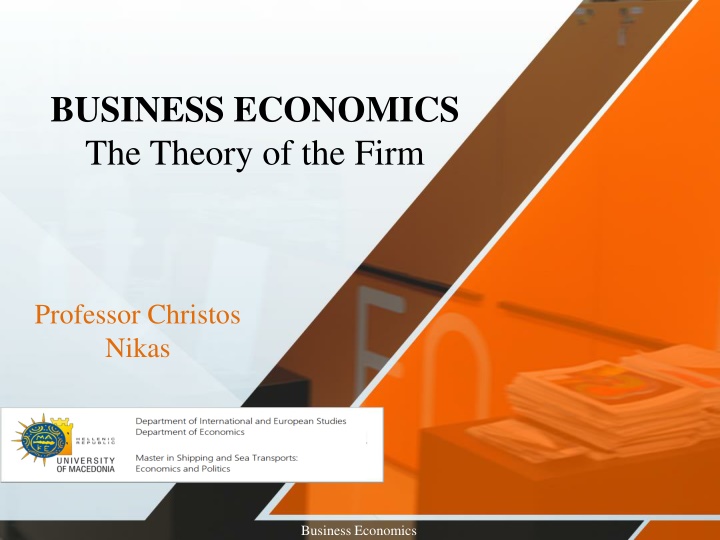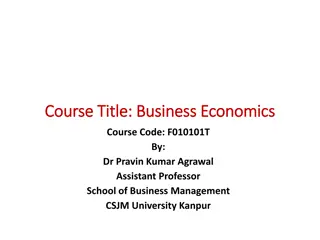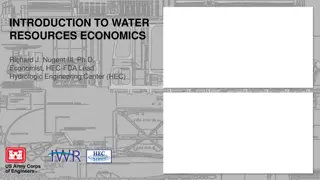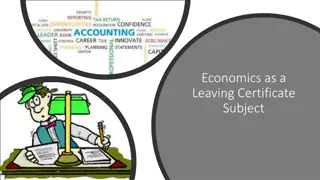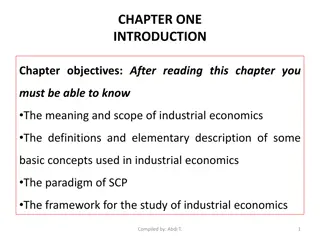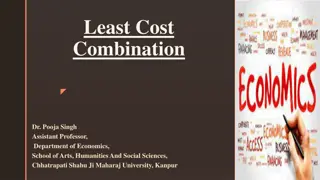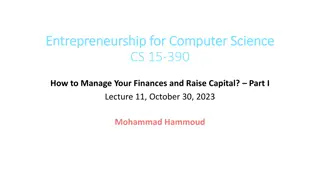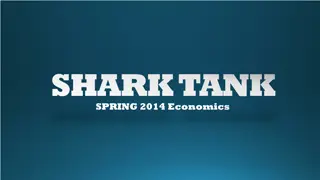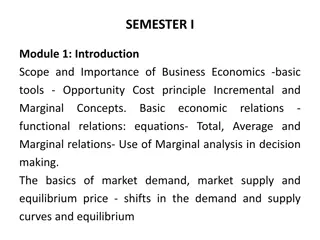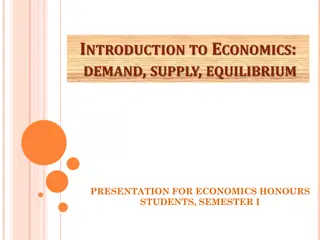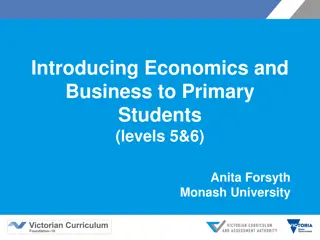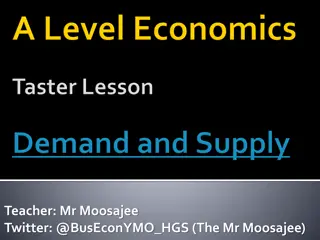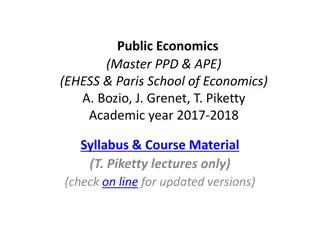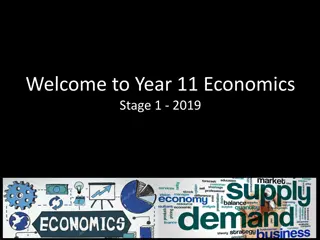BUSINESS ECONOMICS
Examining the theory of the firm and costs of production in business economics, focusing on factors such as resource utilization, productivity, and diminishing marginal returns. Explore how firms optimize production processes to minimize costs and maximize profits through efficient resource allocation.
Download Presentation

Please find below an Image/Link to download the presentation.
The content on the website is provided AS IS for your information and personal use only. It may not be sold, licensed, or shared on other websites without obtaining consent from the author.If you encounter any issues during the download, it is possible that the publisher has removed the file from their server.
You are allowed to download the files provided on this website for personal or commercial use, subject to the condition that they are used lawfully. All files are the property of their respective owners.
The content on the website is provided AS IS for your information and personal use only. It may not be sold, licensed, or shared on other websites without obtaining consent from the author.
E N D
Presentation Transcript
BUSINESS ECONOMICS The Theory of the Firm Professor Christos Nikas Business Economics
The Theory of the Firm The Costs of Production Before anyone can consume to satisfy wants and needs, goods and services must be produced. Producers are profit-seeking, so they aim to produce a salable product at the lowest cost of resources used. Many times this means producing overseas. However, costs are not the only consideration. Productivity is also important. Paying $10 an hour to typist A who types 90 words a minute is a lot cheaper than paying $2 an hour to typist B who types 10 words a minute. Business Economics
The Theory of the Firm The Production Function Production function: a technological relation-ship expressing the maximum quantity of a good attainable from different combinations of factor inputs. In other words, how much can we produce with the land, labor, and capital available? We will consider the land to be a fixed amount. So we can vary only the labor and the capital. In order for labor to produce, it needs land and capital. With neither, production is zero. With fixed land and capital, adding more labor will increase production. Business Economics
The Theory of the Firm The Production Function The productivity of any factor of production (e.g., labor) depends on the amount of other resources (e.g., capital) available to it. Business Economics
The Theory of the Firm The Production Function Note that when capital is fixed, as labor increases, output increases but ultimately at a slower rate. Ultimately output maxes out and begins to decline. The measure of this added output as labor increases is marginal physical product (MPP). Business Economics
The Theory of the Firm Marginal Physical Product (MPP) Business Economics
The Theory of the Firm Diminishing Marginal Returns Law of diminishing returns: the marginal physical product of a variable input declines as more of it is employed with a given quantity of other (fixed) inputs. Added output begins to decrease and ultimately goes negative as more and more workers are added with no increase in capital. Business Economics
The Theory of the Firm Resource Costs The sales manager wants to maximize sales revenue. The production manager wants to minimize production costs. The business owner wants, instead, to maximize profit. There is no reason to expect these three goals to occur at the same output. Business Economics
The Theory of the Firm Resource Costs Business Economics
The Theory of the Firm Resource Costs As MPP decreases with added workers, we continue to pay the added workers, but we get less added product with each added worker. Therefore, the cost per added product increases as MPP declines. Marginal cost (MC): the increase in total cost associated with a one-unit increase in production. Business Economics
The Theory of the Firm Marginal Cost (MC) Change in total cost Marginal cost (MC) = Change in output When MPP decreases, MC must increase, and vice versa. For any production with fixed capital, the MC curve will fall at low levels of production but will rise sharply at higher levels when diminishing marginal returns set in. Business Economics
The Theory of the Firm Costs Total cost (TC): the market value of all resources used to produce a good or service. Fixed cost (FC): costs of production that don t change when the rate of output is altered. Variable cost (VC): costs of production that change when the rate of output is altered. Total Costs = Fixed costs + Variable costs TC = FC + VC Business Economics
The Theory of the Firm Fixed Costs Payments for the fixed inputs. Includes the cost of basic plants and equipment. Must be paid even if output is zero. Do not increase as output increases. Business Economics
The Theory of the Firm Variable Costs Payments for the variable inputs. Include the costs of labor and raw materials. At zero output, these costs are zero. As output increases, variable costs increase rapidly at first, then more slowly, and finally very fast as the firm approaches maximum capacity. Business Economics
The Theory of the Firm Average Costs Average total cost (ATC): total cost divided by the quantity of output in a given time period. ATC = TC / q Average fixed costs (AFC): total fixed cost divided by the quantity of output in a given time period. AFC = FC / q Average variable cost (AVC): total variable cost divided by the quantity of output in a given time period. AVC = VC / q Business Economics
The Theory of the Firm Average Costs Business Economics
The Theory of the Firm Characteristics of the Cost Curves Falling AFC: as output increases, AFC decreases rapidly. Any increase in output will lower AFC. U-shaped AVC: AVC decreases at first, hits a minimum, and then rises as output increases (as a result of diminishing returns). U-shaped ATC: at low output, falling AFC dominates and ATC decreases. As output increases, rising AVC begins to dominate. ATC hits a minimum, then begins to rise.
The Theory of the Firm Minimum Average Cost The output at which ATC switches from being dominated by AFC to being dominated by rising AVC is the point where average costs are minimal. It is at this output where the firm can produce at the lowest cost per unit... and where the firm minimizes the amount of resources being used. However, this amount of output is not necessarily the output where profit is maximized. Business Economics
The Theory of the Firm Marginal Cost (MC) Diminishing returns in production cause MC to increase as output increases. After a brief drop in MC at low output, MC rises rapidly as output increases. As MC rises, it intersects ATC at its minimum point. ATC decreases when MC<ATC. ATC increases when MC>ATC. Business Economics
The Theory of the Firm Long-Run Costs The short run is characterized by fixed costs. In the short run, the plants and equipment are fixed. The objective is to make the best use of those fixed inputs while making the production decision. In the long run, we can change the plants and equipment. Long run: a period of time long enough for all inputs to be varied. There are no fixed costs in the long run. All costs are variable. Business Economics
The Theory of the Firm Long-Run Average Costs In the long run, a firm can build a plant of any desired size. As plant size gets larger, each plant s ATC curve has a lower minimum point. In this case, building a larger plant would lower production costs. Business Economics
The Theory of the Firm Long-Run Average Costs There are unlimited options. One option delivers the lowest ATC. It is at this point where the long-run marginal cost curve intersects the long- run average total cost curve. Business Economics
The Theory of the Firm Economies of Scale Economies of scale: reductions in minimum average costs that come through increases in the size (scale) of plants and equipment. Larger plants reduce minimum average costs. Greater efficiency may come from Specialization vs. multifunction workers. Mass production vs. small batch mode production. Business Economics
The Theory of the Firm Diseconomies of Scale If the plant size gets too big, however, long-run average costs begin to rise, creating diseconomies of scale. Operating efficiency may be reduced. Worker alienation may increase. Rigid corporate structures emerge. Off-site management may be unresponsive. Bigger isn t always better. Business Economics
The Theory of the Firm The Profit Motive The expectation of profit is the basic incentive to produce. Profit: the difference between total revenue and total cost. The profit motive encourages firms to produce the goods and services that consumers desire, at prices they are willing to pay. What will happen to a firm if it produces goods that no consumers want or are willing to pay for? Business Economics
The Theory of the Firm Economic vs. Accounting Profits Economists include all costs in economic costs, both implicit costs (like opportunity cost) and explicit costs. Accountants include only explicit costs. Profit equals total revenue minus total costs. Economic profit, then, is smaller than accounting profit because more costs are subtracted: Economic profit = Total revenue Explicit costs Implicit costs Accounting profit = Total revenue Explicit costs only Economic profit = Accounting profit Implicit costs Business Economics
The Theory of the Firm Normal Profit Normal profit: the opportunity cost of capital. The owner could have invested these resources elsewhere. If the opportunity cost is a lost return of 10%, then the owner will expect at least a 10% return in this business, preferably higher. Normal profit is equivalent to an implicit cost. It is earned if economic profit is zero, which, maybe surprisingly, is the typical case. A productive activity reaps an economic profit only if it earns more than its opportunity cost. Business Economics
The Theory of the Firm Entrepreneurship and Risk The entrepreneur will go into business only if the prospect of earning more is greater than the alternative use of resources. The owner expects a return of more than a normal profit. There is no guarantee of profit. Thus the owner is willing to undertake the risk of suffering economic losses. The inducement to face this risk is the potential for economic profit. Business Economics
The Theory of the Firm Market Structure Market structure: the number and relative size of firms in an industry. The market structures range from monopoly at one extreme to perfect competition at the other extreme. Most real-world firms are along the continuum of imperfect competition. Business Economics
The Theory of the Firm Perfect Competition Characteristics: Many firms compete for consumer purchases. The products of each firm are identical. Low entry barriers make it easy to get into the business. No firm has any market power, thus they cannot manipulate the price. They are price takers. Each firm s output is small relative to the total market amount. Business Economics
The Theory of the Firm Market Demand vs. Firm Demand Although the entire market has a typical downward-sloping demand curve, the individual firm perceives its demand curve to be horizontal. Business Economics
The Theory of the Firm A Firm s Demand Curve Why horizontal? The firm is a price taker. It will charge only the market price. If it raises its price, nobody will buy. If it lowers its price, it will sell out, but it can do that at the market price. It can sell increased quantities at the market price. If you draw a line for any quantity at the market price, the line will be horizontal. Business Economics
The Theory of the Firm The Production Decision There are no pricing decisions. Firms take the market price. There are no quality decisions since all products are identical. The only decision left is how much to produce. This is the production decision. Business Economics
The Theory of the Firm The Production Decision A firm s goal is to maximize profits, not revenues. Profit equals total revenue (price x quantity) minus total costs. The goal is to find the output that maximizes profits. Is h that output? Business Economics
The Theory of the Firm The Production Decision Never produce a unit of output that yields less revenue than it costs. Marginal revenue (MR) is equal to price, the added amount received from selling one more unit. MR =Change in total revenue Change in output Business Economics
The Theory of the Firm The Production Decision As output increases, marginal cost (MC) increases, squeezing the profit from the added units. Compare P to MC: If P>MC, we add to profit by selling that one. If P<MC, we make a loss by selling that one. If P=MC, we make no profit or loss on that one. Business Economics
The Theory of the Firm Profit Maximization Rule For perfectly competitive firms, If P > MC, increase output and profits will grow. If P < MC, decrease output and losses will go away. If P = MC, produce this output because it is the quantity at which profits are maximized. Profit maximization rule: Produce at that rate of output where marginal revenue (MR = P) equals marginal cost (MC). Business Economics
The Theory of the Firm Graphical Look at Profit Maximization Here we relate ATC and MC to P=MR. To maximize profits, choose the quantity related to point b. That is where MR=MC. Note that it is not the same as maximum profit per unit (point a) or maximum revenues (point c). Business Economics
The Theory of the Firm The Shutdown Decision Shutting down the firm does not eliminate all costs. Fixed costs must be paid even if all output ceases. If a firm makes losses, it cannot pay all its fixed costs and its variable costs. The firm will lose less by shutting down (output=0) if losses from continuing production exceed fixed costs. Business Economics
The Theory of the Firm The Shutdown Decision Always set P=MR=MC to maximize profits or minimize losses. If prices fall below ATC, a loss is made. The firm should not shut down until the price falls below AVC. When this happens the firm can t pay its labor and suppliers, so shutting down is the best option. Business Economics
The Theory of the Firm The Investment Decision Investment decision: the decision to build, buy, or lease plants and equipment or to enter or exit an industry. The shutdown decision is a short-run decision. Investment decisions are long-run. Fixed costs are the owners investment in the business. They must generate enough revenue to recoup the investment. Investment will occur if the anticipated (economic) profits are large enough to compensate for the effort and risk. Business Economics
The Theory of the Firm Determinants of Supply A producer will increase output only if profits are increasing. Conversely, a producer will decrease output if profits are decreasing. Each of these determinants affects a producer s willingness and ability to supply a product: The price of factor inputs. Technology. Expectations. Taxes and subsidies. Business Economics
The Theory of the Firm The Short-Run Supply Curve The supply curve shows the quantity a producer is willing to supply at each price. The profit maximization rule leads us to the short-run supply curve. At each price, the producer sets output where MR=MC. The producer resets this output when price changes. Raise the price, produce more. Lower the price, produce less. The marginal cost curve is the firm s short-run supply curve. (and it meets the demand curve Price curve to the point of equilibrium) Business Economics
The Theory of the Firm Supply Shifts If any determinant of supply changes, the supply curve shifts. A change that lowers costs will cause the supply curve to shift right. A change that raises costs will cause the supply curve to shift left. Business Economics
The Theory of the Firm Tax Effects Raising property taxes. Fixed costs and total costs rise, but MC does not. So there is no change in the production decision. Raising payroll taxes. Variable costs and total costs rise, but MC rises also. The MC curve will shift upward to the left, and production output will be decreased. Raising profit taxes. Neither fixed nor variable costs are changed. But owners receive less return and may reduce investment in new business. Business Economics
